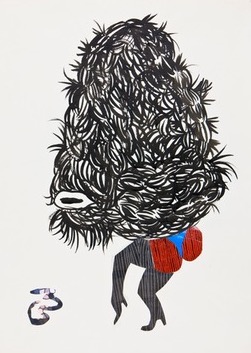Shoshanna Weinberger’s painted works address issues of beauty, power, excess and sexuality – with portraits of strangled figures wrapped in gold and thick fabrics. Wonderland chats to Weinberger about her high-concept projects.
Tell us a bit about yourself and your career to date.
I was born in Kingston, Jamaica and came to America as a young child. I moved to New Jersey and had a pretty active life. Both of my parents were artists so I had a creative childhood. I got my undergraduate degree at the School of the Art Institute of Chicago. I graduated in 1995 and then I got my masters at Yale School of Art in 2003. I now reside in New Jersey where I have a studio.
In your last show at Carol Jazzar Contemporary Art you deal with women, sexuality and power. Are these generally topics you address in your art?
It’s really about investigating my own neuroses in terms of beauty as an aesthetic. I have always been fascinated with hair as a criteria for beauty. My hair is very curly and I would get it blown out and the way people would change their behaviour around me and how it made me look, different or changed. The catalyst of my work is about the criteria of feminine strength or deception or obsession and obsession geared towards and mainly through media and how that drives women to maybe deform themselves with plastic surgery and boob jobs. You look at Joan Rivers and even Michael Jackson – it kind of turns a lovely person into this monster. This body dimorphia. The work is sort of about that. Right now, in my studio, I am doing these Afro puff jungle drawings.
Do you ever feel like you want to keep all your work?
Sometimes! It’s funny but that’s the problem cause then you have a studio full of work. As long as I have a good high-res image I can actually part with it. I make sure I have some kind of archive.
Let’s talk about your newest exhibition, “Sometimes All of Me Is Not Enough”, which ended on Monday. Why did you choose that title and how does it relate to the exhibit?
The imagery is just so over the top and so much about multiplicity. How many boobs do I need to make me feel like I am perfect? I am going to do more to myself to stand out and be an object of desire! I wanted to play off that, with the imagery by saying “Sometimes All of Me is Not Enough.” It’s a humourous play on words. I had another show at Solo Projects in Newark this year. That show was entitled “What Makes my Hottentot so Hot?” and that comes from the carol the lion sings in “The Wizard of Oz” when he is talking about needing courage.
We see imagery like seashells and stripper poles and gold chains in your work in “Sometimes All of Me is Not Enough.” Could you elaborate on the imagery?
The objects themselves in most of my work are voluptuous but then they get strangled by accessories that are feminine so you have bras, you have thongs that kind of get wrapped up around these excessive monstrous deformed forms and then you have gold, a lot of gold chains. I am obsessed actually with making the shape of the gold chains, but along with that, strangling my figures; gold is used as a commodity and is a signifier of wealth and strength. I wanted to play off this idea of money and commodity and beauty and how those work into each other. Somebody of a certain stature has a lot of things and owns a lot of beautiful things so in this way I am taking something that is monstrous or beheaded and by removing that, attacking it and draping it and suffocating it with all this commodity and excess. It’s about excess . That’s what the gold is about. The shells are about my interest in the story of the birth of the Venus.
What do you have coming up next?
I have a new series of drawings I have been working on, going back to hair but putting my figures in places so I am starting to do this jungle series using some of the visual language from “Sometimes All of Me is Not Enough” but I am doing more abstract work that is a little larger. I am also happy to say that one of my drawings has been selected to be on a book cover for Duke University. It’s a book written by Ralina L. Joseph by the title “Transcending Blackness – From the New Millennium Mulatta to Exceptional Multiracial.”
Words: Heike Dempster








